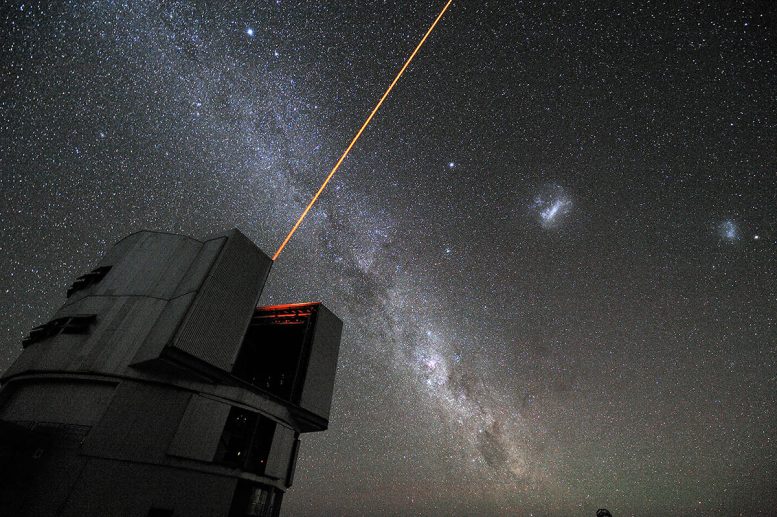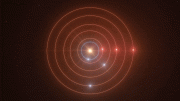
The VLT’s Laser Guide Star: A laser beam launched from VLT’s 8.2-meter Yepun telescope crosses the majestic southern sky and creates an artificial star at 90 km altitude in the high Earth’s mesosphere. The Laser Guide Star (LGS) is part of the VLT’s Adaptive Optics system and it is used as a reference to correct images from the blurring effect of the atmosphere. Credit: ESO / G. Hüdepohl
New research reveals how global warming affects astronomy.
The clarity of the atmosphere above the site from where the observations are taken has a delicate relationship with the quality of the ground-based astronomical observations. Therefore, locations for telescopes are chosen with great care. They are often high above sea level, so there is less atmosphere between them and their targets. Since clouds and even water vapor make it difficult to see the night sky clearly, many telescopes are also constructed in the desert.
In a study presented at the Europlanet Science Congress 2022 in Granada, a group of researchers led by the University of Bern and the National Centre of Competence in Research (NCCR) PlanetS demonstrate how one of the greatest problems of our time, anthropogenic climate change, is now even affecting our view of the cosmos. The study was recently published in the journal Astronomy & Astrophysics.
A blind spot in the selection process
“Even though telescopes usually have a lifetime of several decades, site selection processes only consider the atmospheric conditions over a short timeframe. Usually over the past five years – too short to capture long-term trends, let alone future changes caused by global warming”, Caroline Haslebacher, lead author of the study and researcher at the NCCR PlanetS at the University of Bern, points out.
Therefore, the group of scientists from the University of Bern and the NCCR PlanetS, ETH Zurich, the European Southern Observatory (ESO), and the University of Reading in the UK decided to demonstrate the long-term perspective.
Worsening conditions around the globe
Their analysis of future climate trends, based on high-resolution global climate models, shows that major astronomical observatories from Hawaii to the Canary Islands, Chile, Mexico, South Africa, and Australia will likely experience an increase in temperature and atmospheric water content by 2050. This, in turn, could mean a loss in observing time as well as a loss of quality in the observations.
“Nowadays, astronomical observatories are designed to work under the current site conditions and only have a few possibilities for adaptation. Potential consequences of the climatic conditions for telescopes, therefore, include a higher risk of condensation due to an increased dew point or malfunctioning cooling systems, which can lead to more air turbulence in the telescope dome”, Haslebacher says.
The fact that the effects of climate change on observatories had not been taken into account before was not an oversight, as study co-author Marie-Estelle Demory says, but was not least due to the state of the art: “This is the first time that such a study has been possible. Thanks to the higher resolution of the global climate models developed through the Horizon 2020 PRIMAVERA project, we were able to examine the conditions at various locations of the globe with great fidelity – something that we were unable to do with conventional models. These models are valuable tools for the work we do at the Wyss Academy”, says the senior scientist at the University of Bern and member of the Wyss Academy for Nature.
“This now allows us to say with certainty that anthropogenic climate change must be taken into account in the site selection for next-generation telescopes, and in the construction and maintenance of astronomical facilities,” says Haslebacher.
Reference: “Impact of climate change on site characteristics of eight major astronomical observatories using high-resolution global climate projections until 2050” by C. Haslebacher, M.-E. Demory, B.-O. Demory, M. Sarazin and P. L. Vidale, 2 August 2022, Astronomy and Astrophysics.
DOI: 10.1051/0004-6361/202142493










I would say no. They used a computer simulator named PRIMAVERA, and found “no significant trends are projected for relative humidity, cloud cover, or astronomical seeing and PRIMAVERA does not simulate these variables well compared to observations and reanalyses. Therefore, there is little confidence in these projections”. It only cites the UN’s IPCC report on the anthropogenic climate change, nothing original on that. Their conclusion “that climate change will negatively impact the quality of astronomical observations and is likely to increase time lost due to bad site conditions. We stress that it is essential for astronomers to include long-term climate projections in their process for site selection and monitoring” is already taken into account when building a telescope, as climates always change, and the study was aware of “astronomical facilities with a typical lifetime of 30 yr”, which fits exactly the 30-year standard average of weather to call anything climate, so they’re worried about weather, not climate.